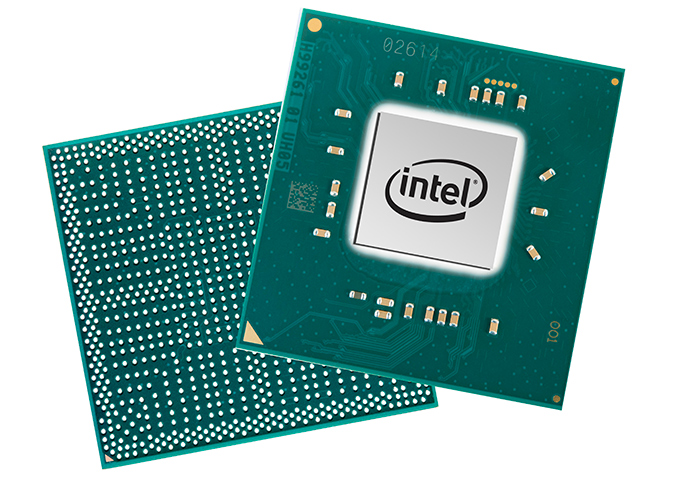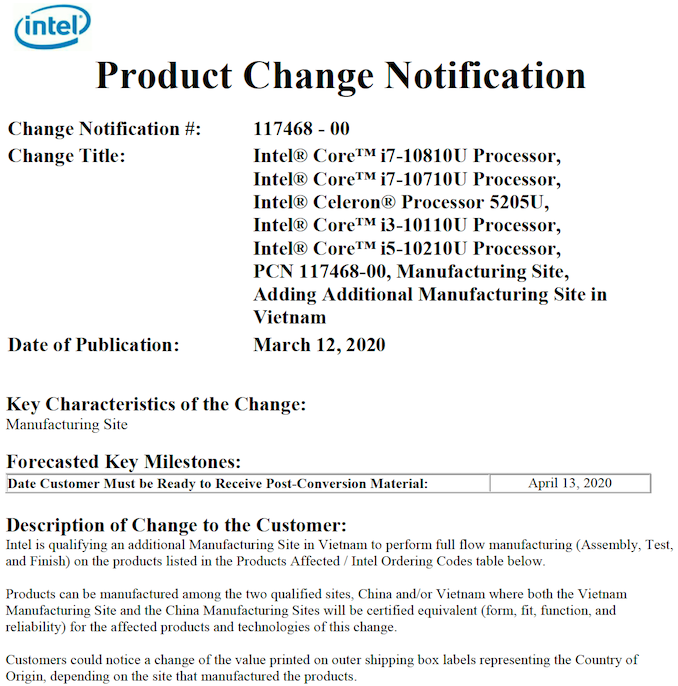New Comet Lake Mobile CPU Spotted in Intel Documents: Core i7-10810U
by Anton Shilov on March 13, 2020 11:35 AM EST- Posted in
- CPUs
- Intel
- U-Series
- 10th Gen Core
- Comet Lake

Intel today published a new Product Change Notification today stating that it has started using an additional Assembly, Test, and Finish site to build its mobile Comet Lake CPUs. In the process, it accidentally disclosed model number of an unannounced processor, the Core i7-10810U. The new chip belongs to the Comet Lake-U family, so it was designed primarily for notebooks.
As the name suggests, the Core i7-10810U would be Intel’s new flagship Comet Lake product sitting right above the Core i7-10710U, which was introduced last summer. In this instance, the new CPU uses the A0 core stepping, which we know from previous disclosures that so it does not support LPDDR4X memory. As we reported back in January, only Comet Lake chips with the K1 core stepping support LPDDR4. Unfortunately, we have no idea about other specifications of the processor, but we asked Intel for additional information on the matter.
Intel from time to time refreshes its client CPUs in Spring in a bid to let PC makers to introduce improved lineup of products, so from this point of view an addition of the Core i7-10810U to the family is not surprising.
| Intel Comet Lake-U SKUs | |||||||||||
| AnandTech | Cores |
Base GHz | 1C Turbo GHz |
AC Turbo GHz |
L3 Cache |
TDP PL1 |
IGP UHD |
IGP MHz |
DDR4 | LPDDR3 | Cost |
| i7-10810U | ? | ? | ? | ? | ? | ? | ? | ? | ? | ? | ? |
| i7-10710U | 6C/12T | 1.1 | 4.7 | 3.9 | 12 MB | 15W | 620 | 1150 | 2666 | 2933 | $443 |
| i7-10510U | 4C/8T | 1.8 | 4.9 | 4.3 | 8 MB | 15W | 620 | 1150 | 2666 | 2933 | $409 |
| i5-10210U | 4C/8T | 1.6 | 4.2 | 3.9 | 6 MB | 15W | 620 | 1100 | 2666 | 2933 | $297 |
| i3-10110U | 2C/4T | 2.1 | 4.1 | 3.7 | 4 MB | 15W | 620 | 1000 | 2666 | 2933 | $281 |
| Pentium 6405U | 2C/4T | 2.4 | - | - | 2 MB | 15W | 610? | 950 | 2400 | ? | $161 |
| Celeron 5205U | 2C/2C | 1.9 | - | - | 2 MB | 15W | 610? | 900 | 2400 | ? | $107 |
Back to the main topic of Intel’s PCN 117468-00 announcement. Starting from April 13, Intel’s OEM customers should be ready to get Core i7-10810U, Core i7-10710U, Core i5-10210U, Core i3-10110U, and Celeron Processor 5205U processors that were assembled in Vietnam. Previously, Intel only used its Assembly, Test, and Finish site in China to build its Comet Lake-U processors, so an additional site may improve availability. Given the local environment surrounding COVID-19, this is also likely Intel hedging its bets with its facilities, in the case that one isn't running.
Related Reading
- Intel Launches Comet Lake-U and Comet Lake-Y: Up To 6 Cores for Thin & Light Laptops
- Intel Launches Low-End Comet Lake CPUs: Pentium Gold 6405U & Celeron 5205U
- Comet Lake-U: LPDDR4(X) Support Misses Original Release, Coming In Next Stepping
- Samsung Updates Galaxy Book Ion: First with Comet Lake & LPDDR4X
Source: Intel












22 Comments
View All Comments
yeeeeman - Friday, March 13, 2020 - link
Let me guess, 5Ghz+ boost frequency?yeeeeman - Friday, March 13, 2020 - link
There is just too little Intel can do with their 14nm parts to counteract Renoir 4000 series. At least on the 15W TDP, they have nothing like the 4800U, that is 8 cores and 16 threads.PeachNCream - Friday, March 13, 2020 - link
11.3GHz, but only for a couple of microseconds. After that it reverts to its base clock of 233MHz until you power cycle the system.Valantar - Friday, March 13, 2020 - link
For a full three seconds, then catastrophic thermal runaway, then a melted hole in the laptop where the CPU used to sit.On a more serious note, I'd guess 4.9. 5+ sounds too high even for short-term single-core turbo on a 6c 15W SKU. I'd guess this is the high-end i7 of this generation like the i7-8650U and 8655U to the "mainstream" 8550U and 8555U in the KBL-R and WL generations, where the former two were nearly only seen in business notebooks (likely due to vPRO support).
Drkrieger01 - Friday, March 13, 2020 - link
I'd be very curious to see the PL2 rating on these CPU's. I imagine they're 15W at something like 1.8-2.2GHz, but at an all core turbo north of 4GHz they probably pull about 130W or more.smilingcrow - Friday, March 13, 2020 - link
4GHz with 6 core is around 65W even on desktop chips so you'd have to push it to get to 130+ watts.That's desktop territory but interesting to see what AMD manage at 7nm/15W.
schujj07 - Friday, March 13, 2020 - link
Actually 6 cores at 3.7GHz is 95W. That is easy to know since that is the 9600K's TDP which has a 3.7GHZ base clock and Intel states TDP off of base clock only.Valantar - Friday, March 13, 2020 - link
That doesn't mean that it can't turbo higher and stay within TDP, just that that is the guaranteed spec that even the worst binned chip of that SKU will maintain within TDP. Most Intel chips outside of the very highest end ones turbo even when strictly limited to TDP, just not by much. Base clocks are also set to differentiate products, after all. 65W chips are a more reliable metric of power draw from TDP as they have less headroom to begin with, and the i7-9700 does 3GHz across 8 cores at 65W. The i5-9600 does just 3.1 at 65W, but it's unlikely it is a bin that much worse than the 9700 (to need 33% more power per core than the i7 for a similar clock speed), so the base clock could likely be higher if that didn't have the potential to cannibalize i7 sales.yeeeeman - Friday, March 13, 2020 - link
If the chassis is cold after a long idle period or if shortly after power on, I think it could sustain high frequencies as it already does. But yeah, after a short while it will fall like a rock. This are the limitation of 14nm...and that is why AMD can do what it does so easily, thanks to TSMC magic.yeeeeman - Friday, March 13, 2020 - link
You will see in a future notebookcheck review of 4800U that it can sustain its turbo quite well. It scores the same as 9880H, which is freaking amazing for a 15W CPU.